1995 PONTIAC BONNEVILLE tow
[x] Cancel search: towPage 9 of 338
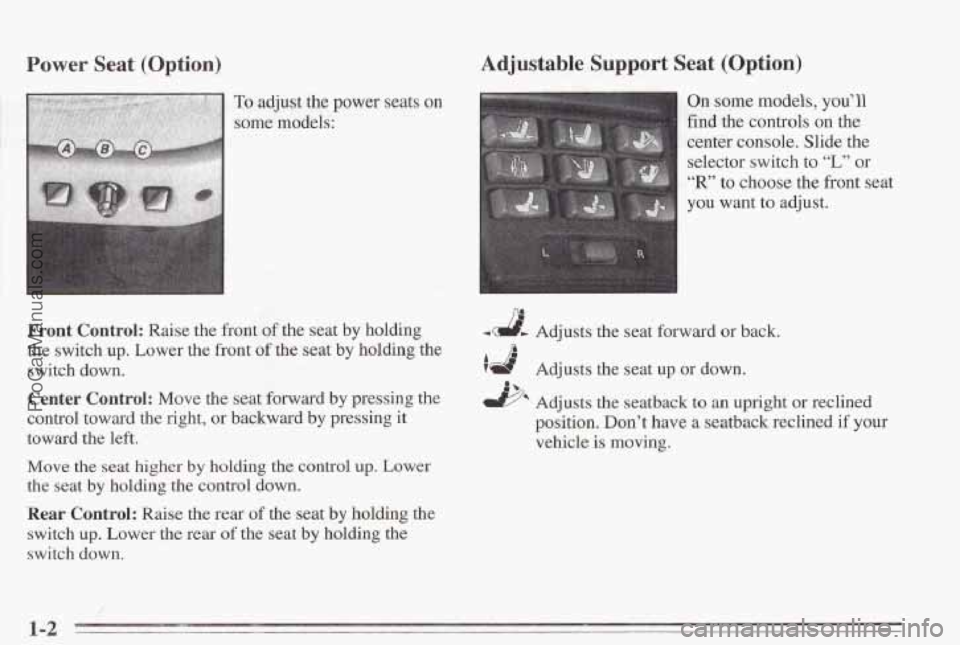
Power Seat (Option)
To adjust the power seats on
some models:
Front Control: Raise the front of the seat by holding
the switch up. Lower the front
of the seat by holding the
switch down.
Center Control: Move the seat forward by pressing the
control toward the right,
or backward by pressing it
toward the left.
Move the seat higher by holding the control up. Lower
the seat by holding the control down.
Rear Control: Raise the rear of the seat by holding the
switch
up. Lower the rear of the seat by holding the
switch down.
Adjustable Support Seat (Option)
On some models,you’Il
find the controls on the
center console.
Slide the
selector switch to
“L” or
“R’ to choose the front seat
4 Adjusts the seat forward or back.
Ad 1 Adjusts the seat up or down.
& Adjusts the seatback ts an upright or re :clin
.ed
position.
Don’t have a seatback reclined if your
vehicle is moving.
1-2 ProCarManuals.com
Page 27 of 338
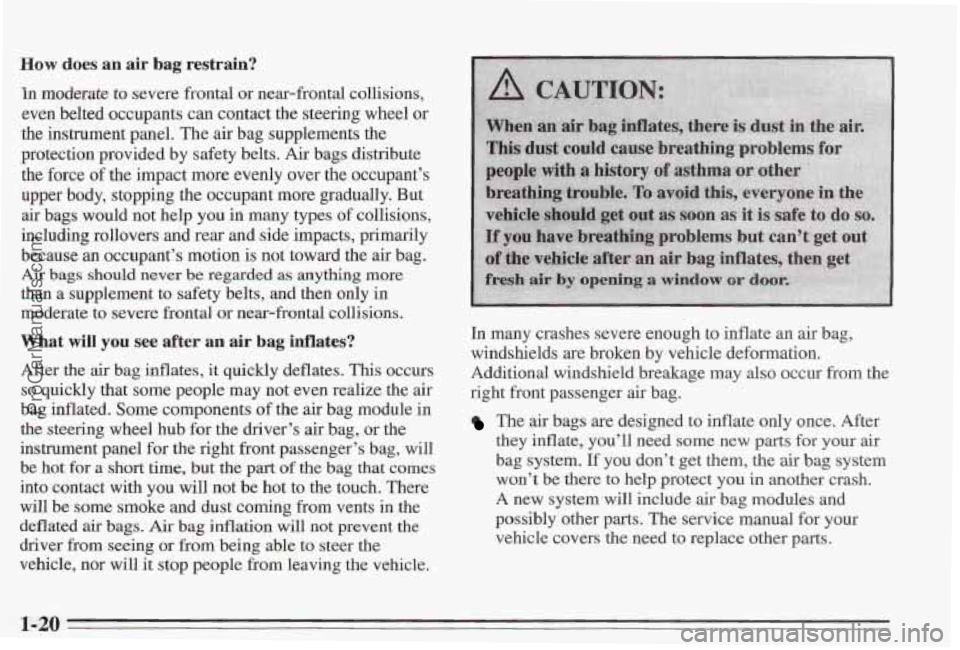
How does an air bag restrain?
In modmate to severe frontal or near-frontal collisions,
even belted occupants can contact the steering wheel or
the instrument panel. The air bag supplements the
protection provided
by safety belts. Air bags distribute
the force of the impact more evenly over the occupant’s
upper
body, stopping the occupant more gradually. But
air bags would not help you in many types of collisions,
including rollovers and rear and side impacts, primarily
because an occupant’s motion is not toward. the
air bag.
Air bags should never be regarded as anything more
than
a supplement to safety belts, and then only in
moderate to severe frontal or near-frontal collisions.
What will you see after an air bag inflates?
After the air bag inflates, it quickly deflates. This occurs
so quickly that some people may not even realize the air
bag inflated. Some components of the air bag module in
the steering wheel hub for the driver’s air bag, or the
instrument panel for the right front passenger’s bag,
will
be hot for a short time, but the part of the bag that comes
into contact with you will not be hot to
the touch. There
will be some smoke and dust coming from vents in the
deflated air bags. Air bag inflation will not prevent the
driver from seeing or from being able to steer the
vehicle, nor will it stop people from leaving the vehicle.
When an air bag inflates, th
This dust could cause breathing problems for
people with
a history of asthma or other
breathing trouble. To avoid this, everyon
vehicle should get out as soon as it is safe to do
If you have breathing problems but can’t get
of the vehicle after an air bag inflates,
fresh air by opening a
In many crashes severe enough to inflate an air bag,
windshields
are broken by vehicle deformation.
Additional windshield breakage may also occur frm the
right Eront passenger
air bag.
The air bags are designed to inflate only once. After
they
inflate; you’ll need some new parts for your air
hag. system. If you Bon’t get them, the air bag system
won’t be there to help protect you
in another crash.
A new sys- wiIl include air bag modules and
possibly other parts. The service md for your
vehicle cov’ers the need to replace other parts.
1-20
ProCarManuals.com
Page 47 of 338
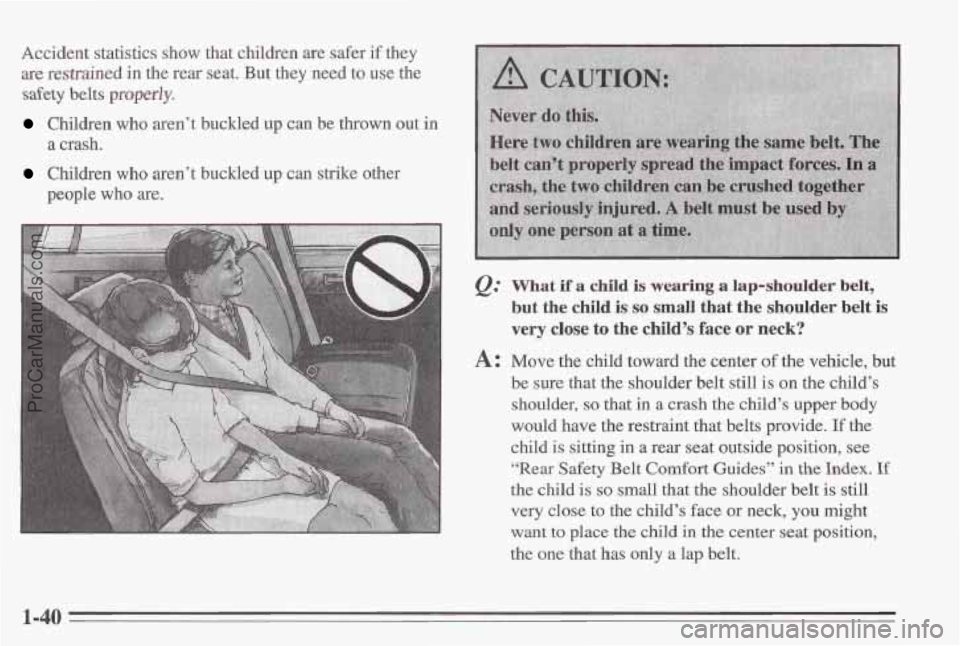
Accident statistics show that children are safer if they
are
restrained in the rear seat. But they need to use the
safety belts properly.
Children who aren’t buckled up can be thrown out in
a crash.
Children who aren’t buckled up can strike other
people who
are.
Q:
A:
What if& child is wearing a lap-shoulder belt,
but the Childkss Snzan Ut the shoulder belt is
very close to the child’s face or neck?
Move the child toward the center of the vehicle, but
be sure that the shoulder belt still is on the child’s
shoulder, so that in a crash the child’s upper body
would have the restraint that belts provide. If the
child is sitting in
a rear seat outside position, see
“Rear
Safety Belt cod^ Guides” in the Index. E
the child is so-small that the shoulder belt is still
very close to the child’s face or neck, you might
want to place the child in
the center seat position,
the one that
has only a lap belt.
1-40
ProCarManuals.com
Page 62 of 338
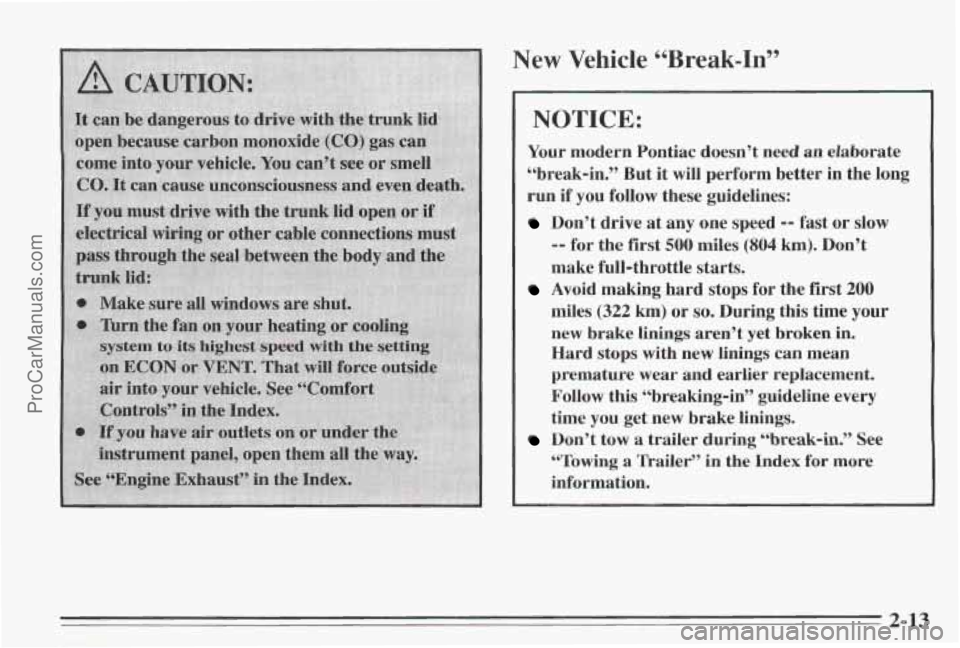
;ystem tu its higlxevt speed with
>n ECON or VENT. That will
air into
your vehicle. See Vornfo
New Vehicle “Break-In”
NOTICE:
Your modern Pontiac doesn’t need an elaborate
“break-in.” But it will perform better in the long
run if you follow these guidelines:
Don’t drive at any one speed -- fast or slow
-- for the first 500 miles (804 km). Don’t
make full-throttle starts.
Avoid making hard stops for the first 200
miles (322 km) or so. During this time your
new brake linings aren’t yet broken in.
Hard stops with new linings can mean
premature wear and earlier replacement.
Follow this “breaking-in” guideline every
time you get new brake linings.
Don’t tow a trailer during “break-in.” See
“Towing a Trailer’’ in the Index
for more
information.
2-13
ProCarManuals.com
Page 63 of 338
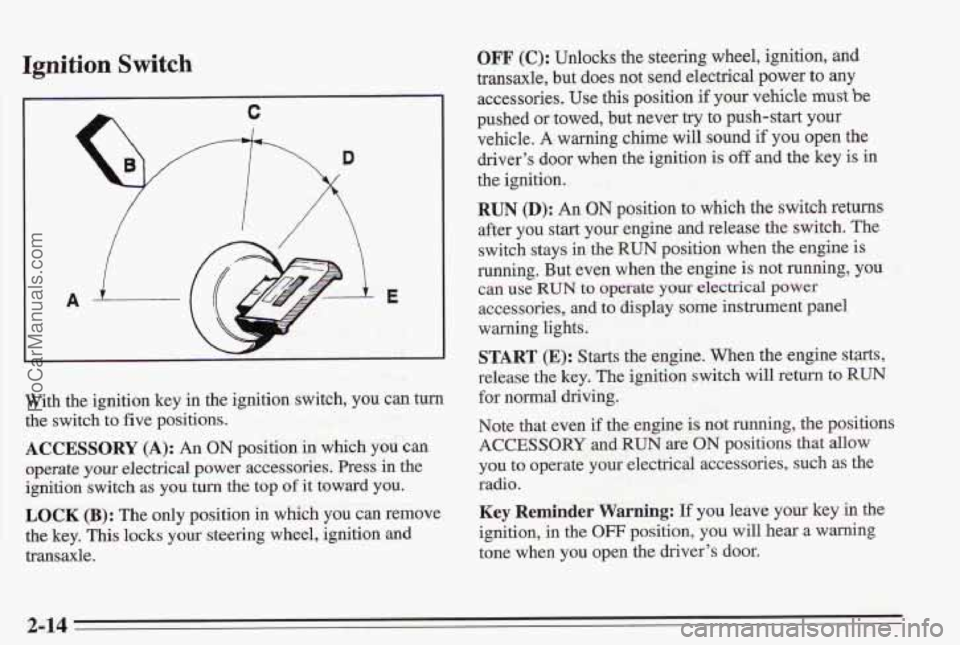
Ignition Switch
With the ignition key in the ignition switch, you can turn
the switch to five positions.
ACCESSORY (A): An ON position in which you can
operate your electrical power accessories. Press in the
igniti’on switch as you turn the top of it toward you.
LOCK (B): The only position in which you can remove
the key, This locks your steering wheel, ignition and
transaxle.
OFF (e): Unlocks the steering wheel, ignition, and
transaxle, but does not send electrical power to any
accessories.
Use this position if your vehicle me be
pushed or towed, but never try to push-start your
vehicle.
A warning cbime will sound if you open the
driver’s door when the ignition
is off and the key is in
the ignition.
RUN 0): An ON position to which the switch returns
after you start your engine and release the switch. The
switch stays in the RUN position when the engine is
running. But even when the engine is not running, you
accessories,
and to display some instrument panel
warning lights.
§TART (E): Starts the engine. When the engine starts,
release de key. The ignition switch will return to
RUN
for normal driving.
Note that even if
the engine is not running, the positions
ACCESSORY and RUN are ON positions that allow
you to operate
yom electrical accessories, such as the
radio.
Key Reminder Warning: If you leave your key in the
ignition, in the OFF position, you will hear a warning
tone when you open the driver’s door.
CEUl Use Rm to QPe3Tit.e yOlar &C!T’kd power
2-14 ProCarManuals.com
Page 65 of 338
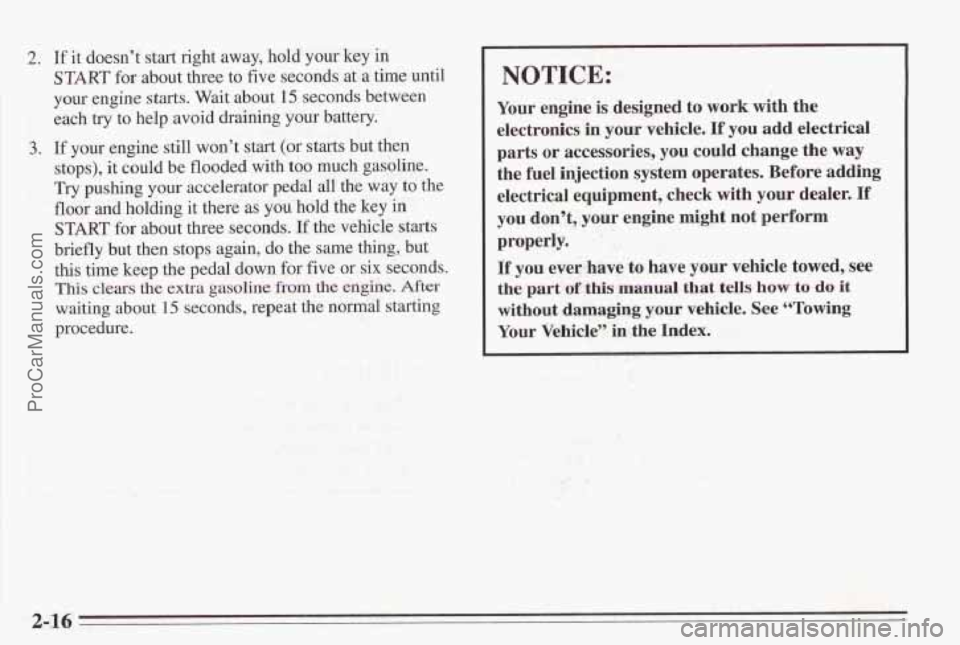
2. If it doesn’t start right away, hold your key in
START for about three to five seconds at a time until
your engine starts. Wait about
15 seconds between
each try
to help avoid draining your battery.
3. If your engine still won’t start (or starts but then
stops), it could be flooded with
too much gasoline.
Try pushing
your accelerator pedal all the way to the
floor and holding it there as you hold
the key in
START for about three seconds. If the vehicle starts
briefly but then stops again, do
the same thing, but
this
time keep the pedal down far five or six seconds.
This clears the extra gasoline €rom the engine. After
waiting about 15 seconds, repeat the nod starting
procedure.
NOTICE:
Your engine is designed to work wkh the
electronics
in your vehicle. If you add electrical
parts or accessories, you could change the way
the fuel injection system operates. Before adding
electrical equipment, check with your dealer.
If
you don’t, your engine might not perform
properly.
If you everhave to have your vehicle towed, see
the part of this manual that tells how to do it
without damaging your vehicle. See “Towing
Your Vehicle” in the lndex.
2-16
ProCarManuals.com
Page 69 of 338
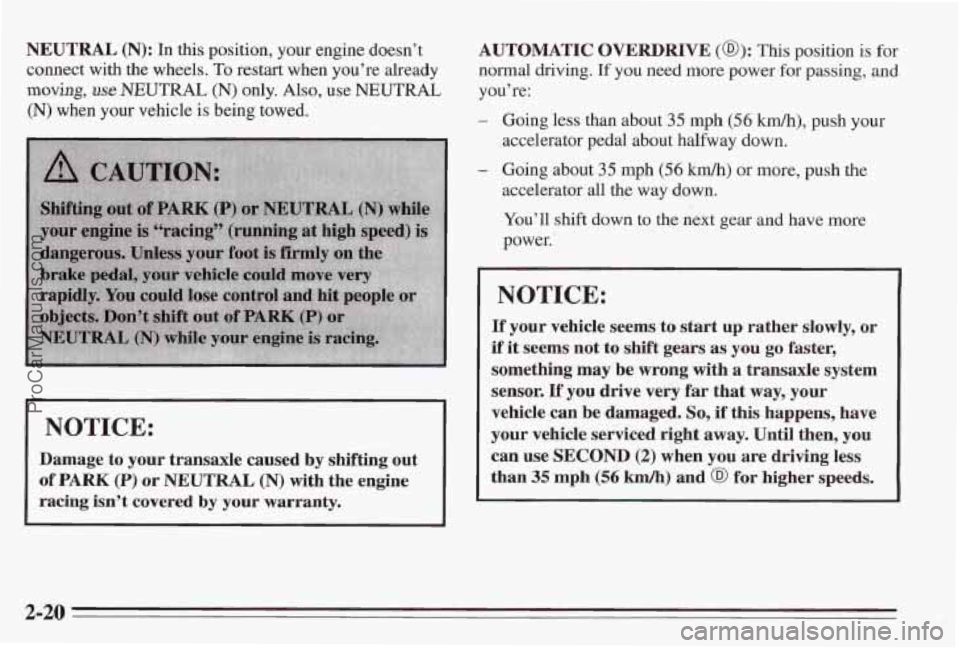
NEUTRAL (N): In this position, your engine doesn’t
connect with the wheels.
To restart when you’re already
moving, use NEUTRAL (N) only. Also, use NEUTRAL
(N) when your vehicle is being towed.
I NOTICE: I
Damage to your transaxle caused by shifting out
of PARK (P) or NEUTRAL (N) with the engine
racing isn’t
covered by your warranty.
AUTOMATIC OVERDRIVE (@): This position is for
normal driving.
If you need more power for passing, and
you’re:
- Going less than about 35 mph (56 km/h), push your
accelerator pedal about halfway down.
- Going about 35 mph (56 lun/h) or more, push the
accelerator all the way down.
You’ll shift down to the next gear and have more
power.
I NOTICE:
If your vehicle seems to start up rather slowly, or
if it seems not to shift gears as you go faster,
something may
be wrong with a transaxle system
sensor.
If you drive very far that way, your
vehicle can be damaged.
So, if this happens, have
your vehicle serviced right away. Until then, you
can use
SECOND (2) when you are driving less
than 35 mph (56 kmh) and @ for higher speeds.
2-20
ProCarManuals.com
Page 70 of 338
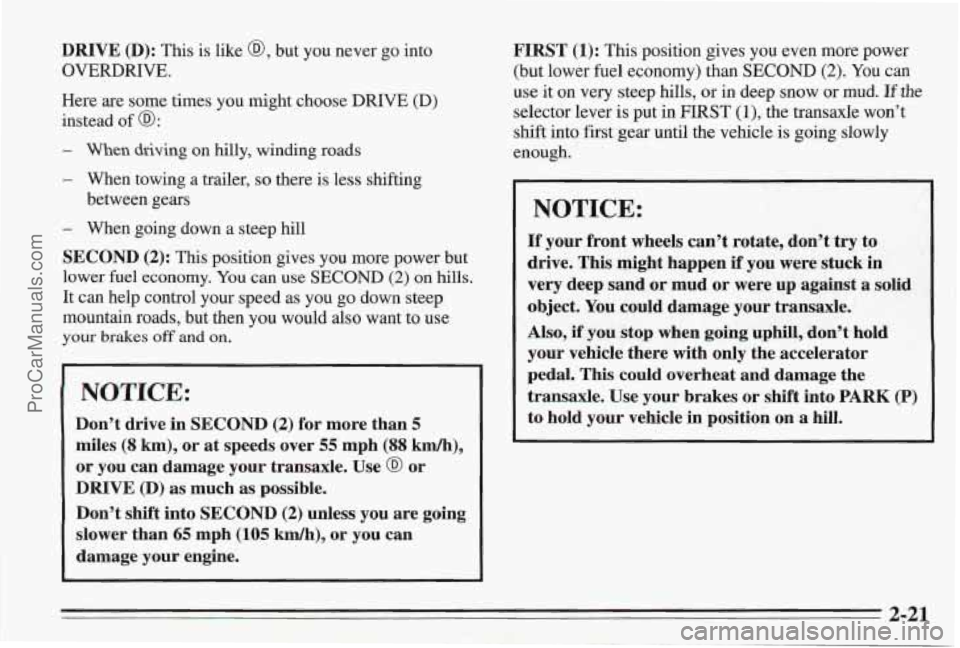
DRIVE (D): This is like @, but you never go into
OVERDRIVE.
Here are some times you might choose DRIVE (D)
instead of
a:
- When driving on hilly, winding roads
- When towing a trailer, so there is less shifting
between gears
- When going down a steep hill
SECOND (2): This position gives you more power but
lower fuel economy. You can
use SECOND (2) on hills.
It can help control your speed as you go down steep
mountain roads, but then you would also want to use
your brakes off and on.
NOTICE:
Don’t drive in SECOND (2) for more than 5
miles (8 km), or at speeds over 55 mph (88 km/h),
or you can damage your transaxle. Use
@ or
DRIVE (D) as much as possible.
Don’t shift into SECOND
(2) unless you are going
slower than
65 mph (105 kd), or you can
damage your engine. FIRST
(1): This
position gives you even more power
(but lower fuel economy) than SECOND
(2). You can
use it on very steep hills, or in deep snow or mud.
If the
selector lever is put in FIRST (l), the transaxle won’t
shift into first gear until
the vehicle is going slowly
enough.
NOTICE:
If your front wheels can’t rotate, don’t try to
drive. This might happen
if you were stuck in
very deep sand or mud or were up against
a solid
object. You could damage your transaxle.
Also,
if you stop when going uphill, don’t hold
your vehicle there with only the accelerator
pedal. This could overheat and damage the
transaxle. Use your brakes or shift into PARK (P)
to hold your vehicle in position on a hill.
2-21
ProCarManuals.com